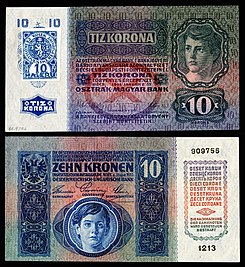The peso is the currency of Chile. The current peso has circulated since 1975, with a previous version circulating between 1817 and 1960. Its symbol is defined as a letter S with either one or two vertical bars superimposed prefixing the amount, $ or ; the single-bar symbol, available in most modern text systems, is almost always used. Both of these symbols are used by many currencies, most notably the United States dollar, and may be ambiguous without clarification, such as CLP$ or US$. The ISO 4217 code for the present peso is CLP. It was divided into 100 centavos until 31 May 1996, when the subdivision was formally eliminated. In February 2023, the exchange rate was around CLP$800 to US$1.
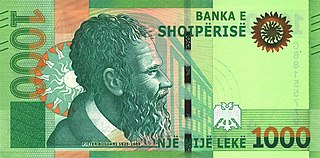
The lek is the currency of Albania. Historically, it was subdivided into 100 qintars.

The krone was the official currency of Austria-Hungary from 1892 until the dissolution of the empire in 1918. The subunit was one hundredth of the main unit, and was called a Heller in the Austrian and a fillér in the Hungarian part of the Empire.
The Congolese franc is the currency of the Democratic Republic of the Congo. It is subdivided into 100 centimes. However, centimes no longer have a practical value and are no longer used. In April 2022, 2,000 francs was equivalent to US$1.

The ariary is the currency of Madagascar. It is notionally subdivided into 5 iraimbilanja and is one of only two non-decimal currencies currently circulating. The names ariary and iraimbilanja derive from the pre-colonial currency, with ariary being the name for a silver dollar. Iraimbilanja means literally "one iron weight" and was the name of an old coin worth 1⁄5 of an ariary. However, as of May 2023, the unit is effectively obsolete since the iraimbilanja has practically no purchasing power, and the coins have fallen into disuse.

The karbovanets or karbovanet, also known as kupon or coupon, has been a distinct unit of currency in Ukraine during three separate periods of the 20th century. It is also a predecessor currency of today's Ukrainian hryvnia.

The koruna, or crown, has been the currency of the Czech Republic since 1993. The koruna is one of the European Union's eight currencies, and the Czech Republic is legally bound to adopt the euro in the future.

The Belgian franc was the currency of the Kingdom of Belgium from 1832 until 2002 when the Euro was introduced. It was subdivided into 100 subunits, each known as a centiem in Dutch, centime in French or a Centime in German.

The Guinean franc is the currency of Guinea. It is subdivided into one hundred centimes, but no centime denominations were ever issued.
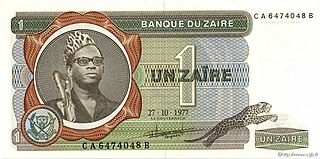
The zaire was the unit of currency of the Democratic Republic of the Congo and then of the Republic of Zaire from 1967 until 1997. All but six of the 79 series of banknotes issued bear the image of Mobutu Sese Seko. Two distinct currencies existed: zaire, and nouveau zaïre.
The Slovak koruna or Slovak crown was the currency of Slovakia between 8 February 1993 and 31 December 2008, and could be used for cash payment until 16 January 2009. The ISO 4217 code was SKK and the local abbreviation was Sk. The koruna was subdivided into 100 haliers. The abbreviation is placed after the numeric value.

The Czechoslovak koruna was the currency of Czechoslovakia from 10 April 1919 to 14 March 1939, and from 1 November 1945 to 7 February 1993. For a brief time in 1939 and again in 1993, it was also the currency of both the separate Czech Republic and Slovakia.

The Bohemian and Moravian koruna, known as the Protectorate crown, was the currency of the Protectorate of Bohemia and Moravia between 1939 and 1945. It was subdivided into 100 haléřů.
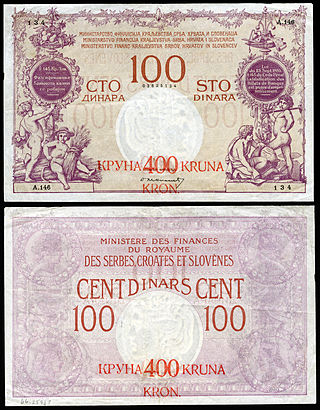
The krone was a short-lived, provisional currency used in parts of the then newly formed Kingdom of Serbs, Croats, and Slovenes, parts of which had previously been part of the Austro-Hungarian Empire (Austria-Hungary). It was worth 1⁄4 of a dinar or 25 para. The name translates into English as crown.

The 10 Polish Złotych note is the lowest value złoty banknote and has been used since the redenomination of the złoty in 1995. The note is used as the sole currency in Poland, a country with a population of about 38 million.

The first official currency of Brazil was the real, with the symbol Rs$. As the currency of the Portuguese empire, it was in use in Brazil from the earliest days of the colonial period, and remained in use until 1942, when it was replaced by the cruzeiro.
The banknotes of the Yugoslav dinar were several series of paper money printed by the central bank of the different consecutive states named Yugoslavia.

In 1945, four kinds of banknotes of Czechoslovak koruna were introduced. The first were issues of Bohemia and Moravia and Slovakia, to which adhesive stamps were affixed. Denominations issued were 100, 500 and 1000 korun. The second were printed in the Soviet Union and were issued in denominations of 1, 5, 20, 100, 500 and 1000 korun. The third were locally printed notes issued by the government in denominations of 1, 5, 10, 20, 50, 100, 500, 1000 and 2000 korun. The fourth were issues of the National Bank of Czechoslovakia, in denominations of 1000 and 5000 korun. The National Bank issued 500 korun notes from 1946, whilst the government continued to issue notes between 5 and 100 korun, the 1 koruna note being replaced by a coin in 1946.
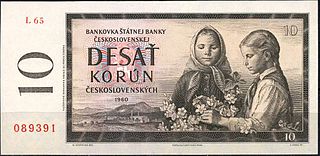
The first banknotes of the third Czechoslovak koruna were issued by the Communist Party of Czechoslovakia in denominations of 1, 3 and 5 korun and by the State Bank in denominations of 10, 25, 50 and 100 korun (banknotes). From 1958, new 25, 10, 100 and finally 50 Kčs banknotes were designed, and the state notes were gradually replaced by coins during the 1960s. The 20 Kčs banknote was printed from 1970 to replace the 25 Kčs note. The 500 Kčs banknote appeared in 1973. Starting with the 1000 Kčs banknote in 1985, a new, more uniform series was issued adding a new denomination each year. This process was interrupted by the fall of the communism : the new 100 Kčs note issued in 1989 depicted Klement Gottwald, a prominent communist and was quickly withdrawn after the Velvet Revolution. A new 500 Kčs banknote was meant to be released by 1990 but had stopped in April of 1990 after the end of communism in Czechoslovakia.

The Slovak koruna or Slovak crown was the currency of the Nazi-era Slovak Republic between 1939 and 1945. The Slovak koruna replaced the Czechoslovak koruna at par and was replaced by the reconstituted Czechoslovak koruna, again at par.
